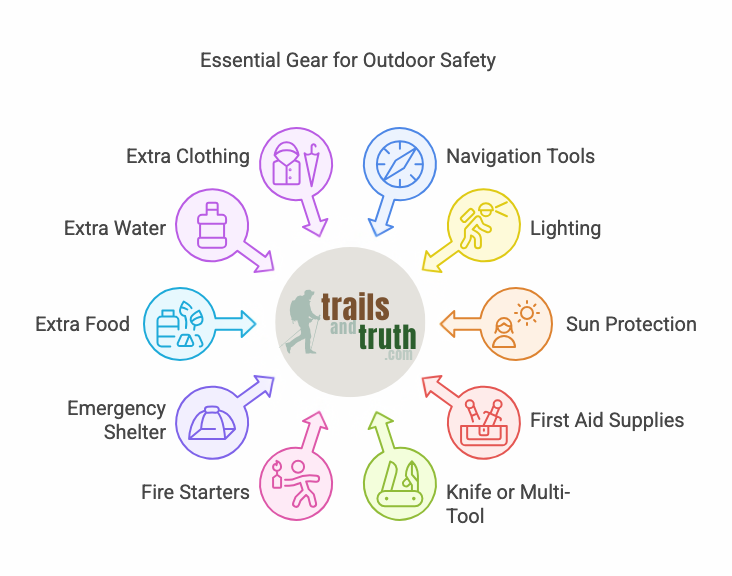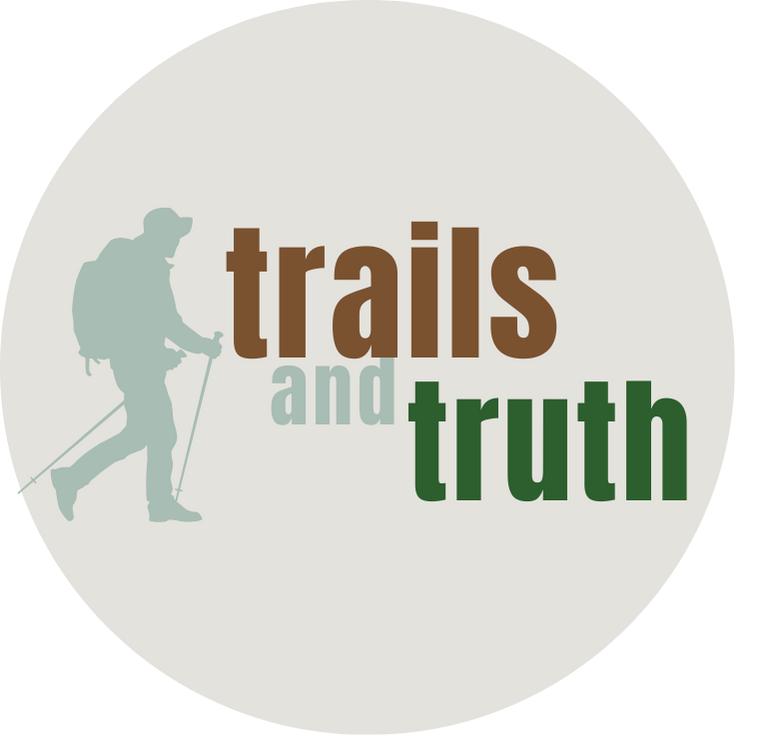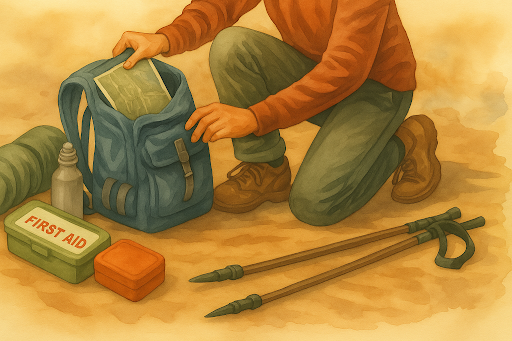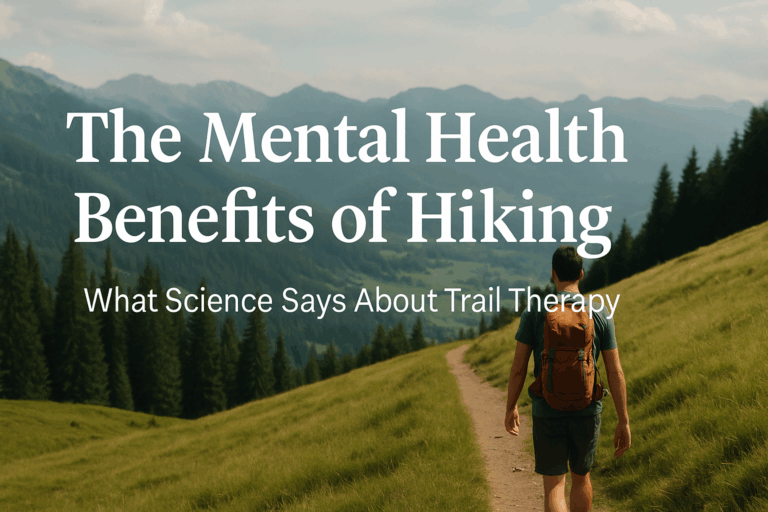What Are The 10 Essentials for Hiking? (‘Official’ List + My Input)
TL;DR for People in a Hurry
The so-called “ten essentials” are your must-have items for any hike — day or multi-day. They’re about staying safe, not overpacking. Here’s the quick list:
- Navigation – Map, compass, GPS (offline-capable)
- Headlamp or Flashlight – Always pack light + spare batteries
- Sun Protection – Sunglasses, sunscreen, SPF lip balm, hat
- First Aid Kit – Blister care, meds, know how to use it
- Knife or Multi-Tool – For repairs, food, emergencies
- Fire – Lighter, waterproof matches, fire starter
- Emergency Shelter – Space blanket, tarp, or bivy
- Extra Food – High-calorie snacks, enough for 1 extra day
- Extra Water + Purification – Drink + treat more if needed
- Extra Clothing – Layers for cold, wind, or rain
Plan smart. Pack light. Stay ready. Keep scrolling for the full breakdown.
Intro: Why the 10 Essentials for Hiking Matter
You don’t plan to get lost. Or stuck.
Or drenched by a surprise thunderstorm.
But the backcountry doesn’t care about your itinerary. 😎
Hiking is one of the purest joys out there. A slow-motion escape into nature’s raw, wild beauty.
But it’s also unpredictable. A clear-sky morning can turn into foggy disorientation by noon. A simple trail can lead you farther from help than you realized.
Throw in ever-changing elevations, and things can get unpredictable… unpredictably fast.
That’s where the “Ten Essentials” come in.
These 10 essentials of hiking aren’t made up by me. The concept actually dates back to the 1930s, popularized by The Mountaineers, a Seattle-based outdoor recreation group. Their aim? Create a standard gear list every hiker could rely on, not just to thrive in the wild, but to survive it.
Since then, the list has evolved, but the core objective hasn’t changed: be prepared, not paranoid.
The Ten Essentials aren’t overkill. Think of them as your insurance policy. A compact toolkit for safety, self-reliance, and smart decision-making — especially if things go sideways.
Because at the end of the day, the best hikes aren’t just the ones with epic views — they’re the ones you come back from.
Section 1: The Ten Essentials: What Every Hiker Needs

Whether you’re tackling a casual trail or venturing into remote wilderness, these are the non-negotiables every hiker (beginner or advanced) should carry.
Each one has earned its spot on this list by saving lives, preventing disasters, and turning potential nightmares into minor hiccups.
1. Navigation: Your Trail Lifeline
Tools to pack:
- Topographic map
- Compass
- GPS device or smartphone with offline maps
- Personal locator beacon (PLB) or satellite messenger
Digital tools are powerful — until they aren’t. Dead batteries, lost signals, and broken screens happen.
A paper map doesn’t glitch, and a compass doesn’t need bars. Together, they give you independence and control in unfamiliar terrain.
If you’re hiking off-grid or in backcountry areas, a PLB adds another layer of security, capable of summoning help even when your phone can’t.
Quick Tip: Before heading out, learn how to orient a map and use a compass. Navigation is a skill, not just an app.
2. Headlamp or Flashlight: Light the Way
Must-haves:
- LED headlamp (hands-free is the way to go)
- Backup batteries or portable charger
You may plan to finish before sunset… but detours, injuries, or a slower pace can shift your schedule fast. When darkness hits, reliable lighting is essential not just for seeing the trail, but for signaling and safety.
Headlamps are ideal because they keep your hands free for climbing, map reading, or first aid.
Don’t take this lightly. Trust me, you need your hands to be free while hiking, especially if you find yourself in a sticky situation.
Choose an LED model for efficiency and longevity, and stash fresh batteries just in case (unless using a rechargeable one).
Quick Tip: Keep your light in an easy-access pocket. Don’t bury it deep in your pack. By the time you need it, you may already be fumbling in the dark.
3. Sun Protection: Shield Yourself
Key items:
- Sunglasses with UV protection
- (Personally, I am slightly torn on this. HubermanLab has drilled the importance of getting sunlight in my eyes so much that I think twice before doing anything to hamper this. However, there are certainly times and situations where it is better to use eye-protection. Do what works best for you and always put safety first.)
- Broad-spectrum sunscreen (SPF 30+)
- SPF lip balm
- Wide-brimmed hat
- Lightweight, sun-protective clothing
Sun damage isn’t just a beach problem. UV exposure can be intense on open ridgelines, alpine slopes, or snowy trails (even on overcast, cloudy days). And don’t be fooled by cooler temps as the sun still goes strong.
Proper protection helps prevent heat exhaustion, sunburn, long-term skin damage, and even eye injuries like snow blindness.
Quick Tip: Reapply sunscreen every 2 hours — and don’t skip the lips. SPF lip balm is one of the most forgotten but crucial items.
4. First Aid Supplies: Be Your Own Medic
What to pack:
- Bandages, antiseptic wipes, blister pads
- Tweezers, scissors, pain relievers
- Personal meds (allergy, asthma, etc.)
- Tape, gauze, safety pins
Blisters. Splinters. Twisted ankles. The trail has its own version of everyday accidents, and they can happen at any time to anyone. A solid first aid kit can be the difference between pushing on and calling it quits (or worse, an otherwise smaller injury turning into a big one).
Blister care is especially critical. Neglect it early, and you’ll feel every step after.
But here’s the real pro move: know how to use what you pack. Taking a basic first aid course (in person or online) arms you with practical skills that go beyond the bandage.
Quick Tip: Tailor your kit to your group size, hike length, and known medical needs. Don’t rely on prepackaged kits. Personalize it and know each item in your kit (also consider reducing unnecessary weight from ‘random’ items in prepackaged kits).
5. Knife or Multi-Tool: Small but Mighty
Essentials include:
- Folding knife or multi-tool
- Duct tape
- Paracord or lightweight cord
This isn’t about fighting bears. It’s about fixing gear, prepping food, slicing moleskin, and improvising solutions when/if the unexpected hits. A good knife or multi-tool is the hiker’s Swiss Army brain in your pocket.
Even a snapped shoelace or broken pack strap can become a big problem when you are miles from help. Cord and duct tape turn a potential situation of “this hike is over 🙁” into “we’re back on track 💪🏽”
Quick Tip: Instead of carrying a whole roll of duct tape, wrap a few feet of duct tape around an object such as your trekking pole, a pencil, or your water bottle (if you don’t find that to be intrusive). This saves space and is always handy when you need it.
6. Fire: Your Backup Plan for Warmth and Help
What to bring:
- Waterproof matches
- Lighter
- Fire starter (cotton balls in petroleum jelly, dryer lint, etc.)
When the temperature drops, fingers start to freeze, or you’re caught out overnight, fire becomes survival. It’s warmth, a signal, and even a morale boost. A reliable fire-starting method is one of the most overlooked (until you need it).
Lighters are convenient, but properly-stored matches still shine in wet or windy conditions. Always bring at least two fire sources, plus a starter that catches fast even when it’s damp.
Quick Tip: Practice safe fire-making before your hike — and know the fire regulations in the area. No one wants to be “that hiker” who sparks a wildfire!
7. Emergency Shelter: Your Last Defense
What happens if you roll an ankle five miles out? Or miss a turn and can’t find your way back before nightfall? Emergency shelter is your fail-safe — a barrier between you and the elements when you can’t make it home.
Even on short day hikes, conditions can shift. A sudden storm, injury, or navigation error can leave you exposed. Packing a space blanket, bivy sack, or ultralight tarp can literally save your life by keeping you dry, conserving heat, and offering protection from rain, wind, and the elements.
Yes, it increases the weight that you’re already carrying. But, these things are available in super lightweight versions as well. If things go wrong, it might be the most important thing in your pack.
Quick tip: Choose something you can deploy solo, even with cold or shaky hands. Practice setting it up before you actually need it.
8. Extra Food: Fuel for the Unexpected
Think of food as energy insurance. You may plan a three-hour hike — but detours, delays, or detachment from reality (those views!) can stretch it much longer.
Bringing extra food means you stay fueled, focused, and clear-headed even when the trail throws curveballs.
How much is “extra”? A good rule of thumb is enough for an extra day than what you have planned, especially on longer or remote routes. So on a day hike, you would pack enough food as if it was an overnight hike into the next day.
Go for calorie-dense, non-perishable, no-cook options: trail mix, nut butter packets, energy bars, jerky, dried fruit. Not gourmet, but good enough to keep you going when you need it most.
Quick tip: Pack snacks you’ll actually eat. A “just-in-case” meal is useless if you hate the taste.
(Personally, I love to carry some dates with me while I hike. They provide a quick shot of healthy energy and also contain electrolytes.)
9. Extra Water (and Purification): Don’t Rely on Streams
Dehydration sneaks up fast, and by the time you feel it, it may already be slowing you down.
Water is the one thing you cannot go without — especially in heat, at elevation, or on strenuous hikes.
Aim for half a liter (16.9 fl oz) per hour of moderate activity, and more in hot or dry conditions. Importantly, you want to have a way to purify what you find also. Filters, iodine tablets, and UV purifiers can turn sketchy water into life-sustaining hydration.
And don’t assume every stream or lake on your map is flowing. Always plan for dry stretches.
Quick tip: Try your purification method before your trip. Some systems have a learning curve, and not all taste great.
10. Extra Clothing: Because Weather Apps Are Not Crystal Balls
Conditions can change rapidly in the wild, and that sunny start can morph into cold rain, biting wind, or even snow.
I was once doing a hike in relatively warmer weather and a few hundred feet in elevation later, a fairly aggressive ‘snow flurry storm’ started out of nowhere. When I got back to the ground later, people had no knowledge of such a thing having happened during that time. Things are different at different elevations.
So what’s the answer then? Layering. Always carry an extra insulating layer (e.g., a fleece or puffy jacket), a waterproof rain shell, and seasonal accessories like a hat, gloves, or buff.
Hypothermia and excessive exposure to the elements is no joke, so please take this seriously. Many hikers have been caught off guard in mild-looking conditions that turned deadly just a few hours later.
Quick tip: Pack your extras in a dry bag or ziplock. Warm clothing doesn’t help much if it’s soaked wet.
Section 2: Making It Work for You
The Ten Essentials aren’t a one-size-fits-all packing list — they’re a flexible framework. The goal isn’t to overload your pack with gear you’ll never touch, but to adapt smartly to the hike you’re taking, the environment you’re walking into, and the risks that might come with it.
Day Hikes vs. Multi-Day Treks
For a short, local day hike, you likely won’t need a full-size stove or a multi-day food stash — but you still need the core essentials. A compact first aid kit, emergency shelter, map, water, and extra food could be what gets you home if plans change.
For overnight or backcountry trips, expand and upgrade:
- A full shelter system instead of just a bivy sack
- Multiple fire-starting methods
- Extra batteries or a small solar charger
- Additional food and water treatment capacity
The longer and farther you go, the more margin for error you’ll want to build into your kit.
Season and Terrain
Winter hiking demands a different loadout than a summer stroll. Think insulation layers, extra gloves, a stove for melting snow, and more calorie-rich food. In contrast, a summer desert hike prioritizes water capacity, sun protection, and light, breathable clothing.
Steep terrain? You might prioritize footwear grip and lightweight gear. Dense forest? Strong navigation tools. Open alpine? Windproof clothing and lightning awareness. Every environment has its own hazards — your gear should anticipate them.
Special Note: Hiking in Bear Country? Add Bear Spray.
If you’re heading into areas known for bear activity — like parts of the Rockies, Pacific Northwest, or upstate New York — bear spray belongs in your kit. It’s one of the most effective deterrents available and has a proven track record of de-escalating encounters with minimal harm.
Tip: Carry it where you can reach it quickly (not buried in your pack), and learn how to use it before hitting the trail. Practice, even just a dry run, can make all the difference in an emergency.
Pack Light, But Pack Smart
Carrying the Ten Essentials doesn’t mean carrying ten pounds of gear. With today’s ultralight options, you can cover every category without overloading. Think minimal, dual-purpose, and quality over quantity.
Smart packing is about preparedness, not paranoia. The Ten Essentials aren’t about making your hike harder — they’re what make sure you finish it safely.
Bottom line: Adapt the list to your hike, but don’t skip the fundamentals. The outdoors rewards those who come ready.
| Essential | What to Bring | Why It Matters |
| Navigation | Map, compass, GPS, offline maps, personal locator beacon | Keeps you on track and helps you get un-lost if tech fails |
| Headlamp/Flashlight | LED headlamp, flashlight, extra batteries | Essential for visibility when daylight runs out unexpectedly |
| Sun Protection | Sunglasses, sunscreen, SPF lip balm, hat, sun-protective clothing | Prevents sunburn, heat exhaustion, and long-term UV damage |
| First Aid Supplies | Bandages, blister care, medications, antiseptic wipes | Treats common trail injuries and ailments quickly and effectively |
| Knife or Multi-Tool | Folding knife, multi-tool, duct tape, paracord | Helps with repairs, first aid, food prep, and emergencies |
| Fire | Lighter, waterproof matches, fire starter | Critical for warmth, cooking, and emergency signaling |
| Emergency Shelter | Space blanket, tarp, bivy sack | Protects you from the elements if stranded or forced to stop overnight |
| Extra Food | Energy bars, trail mix, dried fruit | Keeps energy up and covers you in case of delays or emergencies |
| Extra Water | Water bottles, filter, purification tablets | Prevents dehydration and provides backup if water sources are unreliable or unsafe |
| Extra Clothing | Rain jacket, insulating layer, hat, gloves | Keeps you dry and warm when weather turns or temperature drops |
Final Thoughts: A Smart Hiker Is a Safe Hiker
It’s easy to feel invincible on a blue-sky trail with a gentle breeze and birdsong in the background. But even short hikes can take a hard left — weather turns, trails vanish, ankles roll. And when that happens, the gear you almost brought suddenly becomes the gear you wish you had.
The Ten Essentials aren’t about fear — they’re about respect for nature and self-reliance. They’re your baseline. Your safety net. Your way of saying, “I came prepared, no matter what this trail throws at me.”
Yes, you should adapt the list to your route, the season, and the terrain. No, you don’t have to carry a mountain of gear. But don’t fall into the trap of thinking “it’s just a short hike” is an excuse to leave the basics behind.
Because the smartest hikers aren’t the ones who never run into trouble.
They’re the ones who are ready when it comes.
FAQ: Hiking Essentials
1. Do I really need to bring all Ten Essentials for a short day hike?
Yes — or at least adapted versions of them. Even short hikes can turn into long ones unexpectedly due to injury, weather, or navigation errors. The Ten Essentials are about preparedness, not overpacking.
2. What’s the best way to carry all these items without overloading my backpack?
Focus on lightweight, compact gear and choose multi-use items when possible (e.g., a multi-tool, or clothing that insulates and wicks). A well-organized 20-30L daypack is usually enough for most day hikes.
3. How often should I replace or update my Ten Essentials gear?
Review your kit at the start of each season. Batteries expire, sunscreen breaks down, and maps or tech may need updates. Gear that hasn’t been used in a while should be checked before hitting the trail.
4. Are there any mobile apps you recommend for hiking navigation?
Yes. Popular choices include Gaia GPS, AllTrails, and FarOut. Just be sure to download maps for offline use and bring a backup paper map and compass as a failsafe.
5. Can I customize the Ten Essentials list for different hikes or seasons?
Absolutely. The list is a foundation, not a formula. For summer hikes, you might prioritize water and sun protection; for winter, extra insulation and fire-starting gear become critical. Just don’t skip the core principles of self-reliance and safety.


